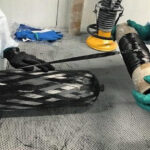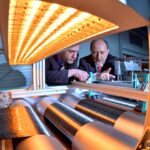Researchers at the University of Colorado Boulder have successfully added a fourth dimension to their printing technology, opening up exciting possibilities for the creation and use of adaptive, composite materials in manufacturing, packaging and biomedical applications.
A team led by H. Jerry Qi, associate professor of mechanical engineering at CU-Boulder, and his collaborator Martin L. Dunn of the Singapore University of Technology and Design has developed and tested a method for 4D printing. The researchers incorporated “shape memory” polymer fibers into the composite materials used in traditional 3D printing, which results in the production of an object fixed in one shape that can later be changed to take on a new shape.
“In this work, the initial configuration is created by 3D printing, and then the programmed action of the shape memory fibers creates time dependence of the configuration – the 4D aspect,” said Dunn, a former CU-Boulder mechanical engineering faculty member who has studied the mechanics and physics of composite materials for more two decades.
The 4D printing concept, which allows materials to “self-assemble” into 3D structures, was initially proposed by Massachusetts Institute of Technology faculty member Skylar Tibbits in April of this year. Tibbits and his team combined a strand of plastic with a layer made out of “smart” material that could self-assemble in water.
“We advanced this concept by creating composite materials that can morph into several different, complicated shapes based on a different physical mechanism,” said Dunn. “The secret of using shape memory polymer fibers to generate desired shape changes of the composite material is how the architecture of the fibers is designed, including their location, orientation and other factors.”
The CU-Boulder team’s findings were published last month in the journal Applied Physics Letters. The paper was co-authored by Qi “Kevin” Ge, who joined MIT as a postdoctoral research associate in September.
“The fascinating thing is that these shapes are defined during the design stage, which was not achievable a few years ago,” said Qi.
The CU-Boulder team demonstrated that the orientation and location of the fibers within the composite determines the degree of shape memory effects like folding, curling, stretching or twisting. The researchers also showed the ability to control those effects by heating or cooling the composite material.
Qi says 3D printing technology, which has existed for about three decades, has only recently advanced to the point that active fibers can be incorporated into the composites so their behavior can be predictably controlled when the object is subjected to thermal and mechanical forces.
The technology promises exciting new possibilities for a variety of applications. Qi said that a solar panel or similar product could be produced in a flat configuration onto which functional devices can be easily installed. It could then be changed to a compact shape for packing and shipping. After arriving at its destination, the product could be activated to form a different shape that optimizes its function.
As 3D printing technology matures with more printable materials and higher resolution at larger scales, the research should help provide a new approach to creating reversible or tunable 3D surfaces and solids in engineering like the composite shells of complex shapes used in automobiles, aircraft and antennas.
The research was funded by the Air Force Office of Scientific Research and the National Science Foundation.
Contact:
Jerry Qi, 720-470-9816
qih@colorado.edu
Courtney Staufer, CU engineering communications, 303-492-7190
Courtney.staufer@colorado.edu
– See more at: http://www.colorado.edu/news/releases/2013/10/22/cu-boulder-researchers-develop-4d-printing-technology-composite-materials#sthash.dSEdFBD6.dpuf












